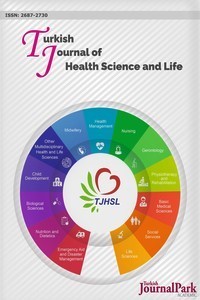REGIONAL VARIATION AND RESULTS OF THE NATURE OF FOREIGN BODY ASPIRATIONS IN SUBTROPICAL REGION
Amaç: Yabancı cisim aspirasyonları çocukluk çağında
özellikle hayatın ilk üç yılında meydana gelen, yaşamı tehdit edebilecek ciddiyette bir solunum
acilidir. Tropik kuşağa yaklaştığımız bölgede karşılaştığımız ilk beş yaştaki
çocuklarca aspire edilen yabancı cisimlerin nitelik olarak değişimini ve
sonuçlarını literatür bilgileri ile karşılaştırmayı amaçladık.Gereç
ve Yöntem: Nyala Sudan Türkiye Eğitim ve Araştırma
Hastanesinde 11/4/2018 ile 30/5/2018 tarihleri arasında 0-5 yaş aralığında 11
olgu anamnez, fizik muayene ve radyolojik görüntüleme sonrasında yabancı cisim aspirasyonu ön tanısı ile kabul
edildi. Tamamına genel anestezi altında rijit bronkoskopi yapıldı, saptanan
yabancı cisimler alligator forceps kullanılarak komplikasyonsuz olarak
çıkartıldı.Bulgular:
En küçük hasta 9 aylık iken en büyüğü 5 yaşında idi ve yaş ortalamaları 2,43
idi. Rijit bronkoskopi ile 5 (%45,45) hastada sağ ana bronştan, 2 (%18,18)
hastada sol ana bronştan, 4 (%36,36) hastada trakeadan yabancı cisim
çıkartıldı. Çıkartılan yabancı cisimlerin 9’u (%81,81) organik ( ekmek,
fıstık, papaya çekirdeği, çekirge, mango), 2’si (%18,18) inorganik
(taş, pil) idi.
Sonuç: Gelişmiş ve eğitimli coğrafyalarda konu ile
ilgili ebeveynlere ulaşabilmek, farkındalık yaratabilmek kolay iken sosyoekonomik
düzeyi düşük, iletişim ve ekonomik sıkıntı yaşayan alanlarda zordur. Yabancı
cisim aspirasyonları nitelik açısından pek çok sebebe bağlı olarak subtropik
kuşakta farklılık göstermektedir fakat oluşturabileceği komplikasyonlarda bir
farklılık yoktur.
Anahtar Kelimeler:
Yabancı cisim aspirasyonu, Çocukluk, Rijit bronkoskopİ
REGIONAL VARIATION AND RESULTS OF THE NATURE OF FOREIGN BODY ASPIRATIONS IN SUBTROPICAL REGION
Aim: Foreign body
aspirations are a serious respiratory illness that can threaten life,
particularly in childhood, in the first three years of life. We aimed to
compare the qualitative changes and their results of the asphyxiated foreign
bodies of the first five-year-old children we encountered in the tropical
region with literature.Material and Method: In Nyala Sudan Turkey Education and Research Hospital, 11 patients in the
range of 0-5 years between the dates of 04/11/2018 and 05/30/2018 with history
of foreign body aspiration was accepted after a physical examination and
radiological imaging with a preliminary diagnosis.All patients underwent rigid
bronchoscopy under general anesthesia, foreign bodies detected were removed by
using alligator forceps with no significant complication. Results:
The youngest patient was 9 months old while the oldest was 5 years old
and the average age was 2.43. Foreign bodies were removed by rigid bronchoscopy
in 5 (45.45%) patients from the right main bronchus, 2 (18.18%) in the left
main bronchus and 4 (36,36%) in the trachea. Nine (81,81%) of the extracted
foreign bodies were organic (bread, peanut, papaya, grasshopper, mango) and 2
(18,18%) were inorganic (stone, battery).Conclusion:
In advanced countries, it is easy to reach parents and raise awareness
about the subject, but this is a difficult situation in regions where
socioeconomic level is low, communication and economical problems are
experienced. Foreign body aspirations may differ in the subtropic belt due to
many challanging conditions, but there is no difference in the complications
that can be encounteredat the end.
Keywords:
Foreign body aspiration, Child, rigid bronchoscopy,
___
- Referans1. Liman ŞT, Eliçora A, Topçu S. Yabancı cisim aspirasyonları ve özofagus yabancı cisimleri. Toraks Cer Bült. 2012; 3(2) p. 94-103.
- Referans2. Kolbakır F, Keçegil HT, Ankan A, Erk MK. Yabancı cisim aspirasyonları bronkoskopi yapılan 152 olgunun analizi. GKD Cer Derg. 1995; 3 p. 117-120.
- Referans3. Black RE, Choi KJ, Syme WC, et al. Bronchoscopic removel of aspirated foreign bodies in children. Am J Surg . 1984; 148 p. 778- 781.
- Referans4. Kaya A, Bilgin UE, Şenol E ve ark. İzmir’de yapılan bebeklik dönemi adli otopsiler: 1999-2007. Ege Tıp Derg. 2010; 49 p. 177-184.
- Referans5. Eren S, Balcı AE, Dikici B, et al. Foreign body aspirationin children: experience of 1160 cases. Ann Trop Pediatr 2003; 23 p.31-37.
- Referans6. Even L, Heno N, Talmon Y, et al. Diagnostic evaluation of foreign body aspiration in children: a prospective study. J Pediatr Surg. 2005; 40 p.1122-1127.
- Referans7. Zerella JT, Dimler M, McGill LC, Pippus KJ. Foreign body aspiration in children: value of radiography and complications of bronchoscopy. J Pediatr Surg. 1998; 33 p.1651-1654.
- Referans8. Eroğlu A, Kürkçüoğlu IC, Karaoğlanoğlu N, et al. Tracheobronchial foreign bodies: a 10 year experience. Ulus Trav Acil Cerr Derg. 2003; 9 p. 262-266.
- Referans9. Arana A, Hauser B, Hachimi-Idrissi S, Vandenplas Y. Management of ingested foreign bodies in childhoodand review of the literature. Eur J Pediatr. 2001; 160 p.468-472.
- Referans10. Paşaoğlu I, Doğan R, Demircin M, Hatipoğlu A, Bozer AY. Bronchoscopic removal of foreign bodies in children retrospective analysis of 822 cases. Thorac Card Surg. 1991;39 p. 95-98.
- ISSN: 2687-2730
- Başlangıç: 2018
- Yayıncı: Mümin POLAT
Sayıdaki Diğer Makaleler
MOLAR-INCISOR HYPOMINERALIZATION: WHY DOES IT OCCUR? / WHAT TO DO?
Md Mizanur RAHMAN, Mohamad Taha ARİF, Razitasham SAFİİ, Zainab TAMBİ, Cliffton AKOİ, Zulkifli JANTAN, Drend JORES, Winnie JOHNNY
ANALYSIS OF PATIENTS WITH BLUNT THORAX TRAUMA AND RIB FRACTURE; EVALUATION OF 201 CASES
Ahmet DUMANLI, Adem GENCER, Furkan KAYA, Canan İNCEOĞLU, Gürhan ÖZ
REGIONAL VARIATION AND RESULTS OF THE NATURE OF FOREIGN BODY ASPIRATIONS IN SUBTROPICAL REGION
